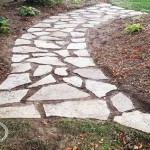How to Build a Stone Patio Wall
A stone patio wall can be a stunning addition to any outdoor space. It can define areas, enhance privacy, and create visual interest. While building a stone wall might seem daunting, with proper planning, preparation, and technique, it can be a rewarding DIY project. This article will guide you through the process of building a stone patio wall, outlining the key steps for a successful outcome.
Planning and Preparation
Planning is crucial for any construction project, and a stone wall is no exception. Before you break ground, consider the following:
1.
Design and Purpose:
What is the primary function of your wall? Will it be a retaining wall, a privacy wall, or a decorative element? The chosen design will impact the materials, construction techniques, and overall appearance.2.
Location and Size:
Determine the exact location, length, and height of the wall. Consider the existing landscape, drainage, and proximity to other structures. Ensure the wall's size and placement are in line with local building codes and regulations.3.
Materials:
The choice of stone can significantly affect the look and cost of your project. Common options include flagstone, fieldstone, and manufactured stone veneer. Research the properties of each material, their availability in your area, and their suitability for your design.4.
Tools and Equipment:
Gather the necessary tools, including a shovel, tamper, level, trowel, mortar mixer, and safety gear. Consider renting specialized equipment like a concrete mixer or a stone cutting saw if needed.Foundation and Base
A solid foundation is essential for a durable and stable stone wall. The steps involved in building the foundation include:
1.
Excavation:
Dig a trench along the proposed wall line, with a width slightly wider than the wall's base and a depth determined by local frost line requirements and the wall's height. The trench should have a slope of about 2-3 inches per 10 feet for proper drainage.2.
Foundation Preparation:
Fill the trench with a 4-6 inch layer of compacted gravel to provide drainage and support. Level the gravel surface and compact it thoroughly using a tamper or plate compactor.3.
Concrete Pour:
Pour a thin layer of concrete over the compacted gravel, ensuring it is level and uniform. The concrete layer should be thick enough to support the weight of the stones.4.
Curing:
Allow the concrete to cure for at least 24 hours before proceeding to the next step. This ensures the concrete gains sufficient strength to support the wall.Laying Stone and Mortar
Laying stones with mortar is a meticulous process that requires patience and attention to detail. The following steps will help you achieve a professional-looking result:
1.
Mortar Preparation:
Mix the mortar according to the manufacturer's instructions. The mortar should be a workable consistency, allowing for easy spreading and shaping.2.
Laying the First Course:
Start by laying the first course of stones on the concrete foundation. Ensure each stone is level and plumb using a level and plumb line. Spread a layer of mortar between the stones, leaving a small gap for expansion and drainage.3.
Continue Laying Courses:
Lay successive courses of stones, staggering the joints to create a more stable and aesthetically pleasing pattern. Use a level and plumb line to maintain alignment and ensure each course is level with the previous one.4.
Grouting:
Once the mortar has set, fill the gaps between the stones with grout. This will enhance the wall's appearance and prevent water penetration.5.
Finishing Touches:
Clean the wall with a damp cloth to remove excess mortar and grout. Consider adding decorative features such as caps or coping stones to enhance the wall's aesthetics and protect the top of the wall from weathering.Important Considerations
For a successful stone patio wall construction project, keep the following points in mind:
1.
Local Building Codes:
Consult local building codes and regulations before starting your project. These regulations vary depending on your location and may address aspects like foundation depth, wall height, and structural requirements.2.
Drainage:
Proper drainage is crucial for preventing damage to the wall and surrounding landscape. Ensure that the wall has a slight slope towards the drainage area and that the ground around the wall is graded to prevent water from accumulating.3.
Weather Conditions:
Avoid working in extreme weather conditions, such as rain, snow, or freezing temperatures. These conditions can affect the curing of concrete and mortar, compromising the wall's integrity.4.
Professional Assistance:
If you are unsure about any aspect of the project or if your wall involves complex design elements or significant height, consider seeking professional guidance from a contractor or mason.Building a stone patio wall can be a challenging but rewarding project. By carefully planning, preparing, and following the steps outlined above, you can create a beautiful and durable addition to your outdoor space. Remember to prioritize safety, attention to detail, and local building regulations for a successful outcome.

How To Build A Patio Enclosure With Seating Walls

How To Build Strong Patio Walls

How To Build A Patio Seating Wall Or Panel

How To Build A Raised Patio With Retaining Wall Blocks

How To Build A Patio Seat Wall Getting Started Hardscaping Construction Tips
:strip_icc()/100844539-how-to-d570e76b957d4f23839a024e7faaf996.jpg?strip=all)
How To Build Retaining Wall On A Slope

Build Your Own Stone Wall Irwin

How To Build A Patio Enclosure With Seating Walls

Backyard Landscaping How To Build A Dry Stacked Stone Retaining Wall Buechel

Build A Flagstone And Stone Block Patio Diy Family Handyman








